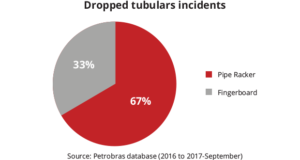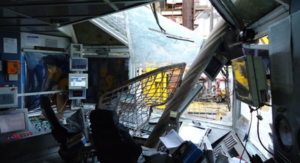Petrobras, IADC Brazil Chapter collaborate to prevent dropped tubular incidents on the drill floor
Working group of drilling contractors and manufacturers was created to develop an action plan, reducing main cause of these events by 80%
By Gabriel da Silva Felipe, Petrobras
Pipe handling is a routine task in drilling and completion activities where tubulars of different types and diameters are assembled, disassembled and moved using systems with different levels of automation, safety and integration. These operations can be repetitive, have a long duration and require the comprehensive attention of all team members involved in the task. In the midst of this scenario lies the risk of dropped stands, which can lead to injuries or even fatalities.

In the first half of 2017, an increased number of incidents involving the fall of pipe stands across the derrick drew the attention of Petrobras, and the operator set out to establish a specific initiative to prevent these incidents from occurring. Initially, a study was conducted to identify the main causes of these events.
The study found that 67% of the events were related to the pipe racker and 33% to the fingerboard. In case of pipe racker incidents, 88% of these incidents were caused by operating errors, including a large number of events that happened during the handshake between the elevator and the pipe rack. This was identified as the main cause of incidents in this period.
In those events that were related to the fingerboard, 80% were caused by a deficiency in maintenance or an equipment failure (control valves and latches/actuators).
Addressing the issue in a comprehensive and collaborative manner, Petrobras presented the study to the IADC Brazil Chapter in September 2017 and proposed the creation of a working group. The goal was to develop an action plan that would prevent pipe stands from falling in the drill floor. For three months, a group of 10 drilling contractors met to discuss operating and maintenance practices. The group also had the support of two manufacturers of pipe-handling equipment.

The practices that were selected by the group were then incorporated into drilling contractors’ procedures and maintenance plans. In parallel, engineering solutions and upgrades have also been tracked to make pipe-handling operations safer.
Control and the analysis of the incidents was improved through the use of business intelligence-based software that makes it possible to quickly diagnose the common causes of the incidents in the fleet and in each drilling contractor. Based on the diagnostics and the lessons learned in each event, Petrobras has promoted semiannual campaigns for the operation and maintenance teams onboard.
The company believes that knowledge of the risks and dissemination of good practices and lessons learned are very important for the prevention of pipe stand falls.
As a result of the action plan, the fall of pipe stands during the handshake between the elevator and the pipe racker was reduced by 80% in 2018, and the rate of pipe stand falls was reduced by 40% in 2019, compared with 2017. The practices and lessons learned are outlined below.
Pipe Racker
- Update the pull out of the hole (POOH) procedure:
- Driller picks up the stand and sets same on slip.
- Assistant Driller (AD) moves the pipe racker and engages the arms.
- AD breaks out, spins out and lifts the stand a couple of inches.
- Driller opens the elevator and starts to lower the block.
- Some systems allow latches to be opened out of the target of the pipe racker, but some equipment manufacturers offer an upgrade that would eliminate this risk.
Fingerboard and Bellyboard
- Establish a cleaning routine to minimize the possibility of latches to become stuck.
- Define a spotter in a safe position and in permanent communication with the operator of the pipe racker to see the movement into the fingerboard.
- Reflective tape on the fingerboard can assist night viewing.
- Establish a corrective and preventive maintenance control for each latch.
- Establish strict control over air quality, with improved filtration.
- When handling pipes in override/maintenance mode, check if the control system has registered the pipe at the designated position. On some systems, this record does not occur automatically and must be done manually.
- At the beginning of each shift, compare the number of pipes in the fingerboard with the number of pipes recorded in the control system to correct any discrepancy.
- Check the proper adjustment of the fingerboard air silencers. In some systems, the clogging of the silencers installed in the vent lines of the valves can cause malfunction of the latches.
General Recommendations
Communication
- Maintain good communication among those involved in pipe handling.
- Check the operation and battery level of the radios.
- Check the camera operations.
Operation planning and management of change
- Check materials, equipment and accessories that will be used in the operations. Reassess risks in the event of changes in personnel, weather conditions, equipment failure, or the planed operations.
- Any bypass of safety systems and interlocks must have management of change and leadership approval.
- During troubleshooting and post-repair tests, establish a second barrier or remove the pipe from the equipment to avoid inadvertent/accidental commands, which can lead to a pipe drop.
- Never reset the controllers with suspended loads, and check the equipment settings, including sensor adjustment, before and after a reset.
Safe position
- Define the safe positioning of the team during the movement of pipes in the drill floor. Respect the red zone during pipe-handling operations. DC
The author acknowledges the contributions of IADC Brazil Members, Ricardo Barroso Ballona (Petrobras), Lucas Saber Rocha (Petrobras), Jorcy de Oliveira Neto (Petrobras) and Juliano Valle de Lima (Petrobras).




